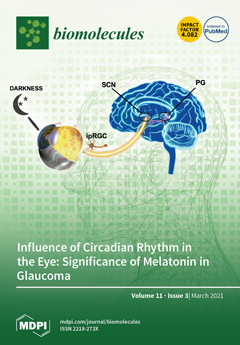The huge global expansion of the COVID-19 pandemic caused by the novel SARS-corona virus-2 is an extraordinary public health emergency. The unavailability of specific treatment against SARS-CoV-2 infection necessitates the focus of all scientists in this direction. The reported antiviral activities of guanidine alkaloids encouraged us to run a comprehensive in silico binding affinity of fifteen guanidine alkaloids against five different proteins of SARS-CoV-2, which we investigated. The investigated proteins are COVID-19 main protease (M
pro) (PDB ID: 6lu7), spike glycoprotein (PDB ID: 6VYB), nucleocapsid phosphoprotein (PDB ID: 6VYO), membrane glycoprotein (PDB ID: 6M17), and a non-structural protein (nsp10) (PDB ID: 6W4H). The binding energies for all tested compounds indicated promising binding affinities. A noticeable superiority for the pentacyclic alkaloids particularly, crambescidin 786 (
5) and crambescidin 826 (
13) has been observed. Compound
5 exhibited very good binding affinities against Mpro (ΔG = −8.05 kcal/mol), nucleocapsid phosphoprotein (ΔG = −6.49 kcal/mol), and nsp10 (ΔG = −9.06 kcal/mol). Compound
13 showed promising binding affinities against M
pro (ΔG = −7.99 kcal/mol), spike glycoproteins (ΔG = −6.95 kcal/mol), and nucleocapsid phosphoprotein (ΔG = −8.01 kcal/mol). Such promising activities might be attributed to the long ω-fatty acid chain, which may play a vital role in binding within the active sites. The correlation of c Log P with free binding energies has been calculated. Furthermore, the SAR of the active compounds has been clarified. The Absorption, Distribution, Metabolism, Excretion, and Toxicity (ADMET) studies were carried out in silico for the 15 compounds; most examined compounds showed optimal to good range levels of ADMET aqueous solubility, intestinal absorption and being unable to pass blood brain barrier (BBB), non-inhibitors of CYP2D6, non-hepatotoxic, and bind plasma protein with a percentage less than 90%. The toxicity of the tested compounds was screened in silico against five models (FDA rodent carcinogenicity, carcinogenic potency TD
50, rat maximum tolerated dose, rat oral LD
50, and rat chronic lowest observed adverse effect level (LOAEL)). All compounds showed expected low toxicity against the tested models. Molecular dynamic (MD) simulations were also carried out to confirm the stable binding interactions of the most promising compounds,
5 and
13, with their targets. In conclusion, the examined 15 alkaloids specially
5 and
13 showed promising docking, ADMET, toxicity and MD results which open the door for further investigations for them against SARS-CoV-2.
Full article






